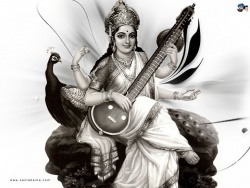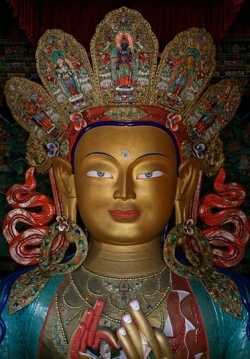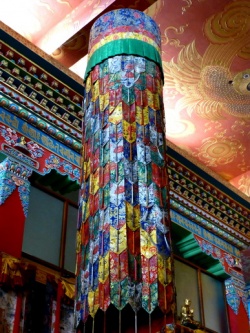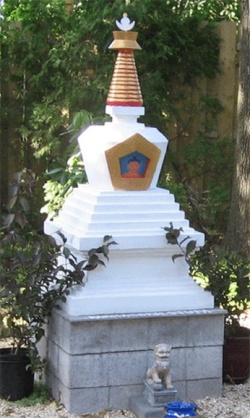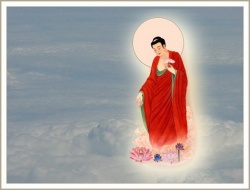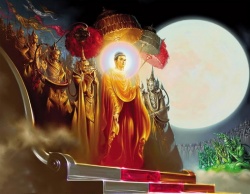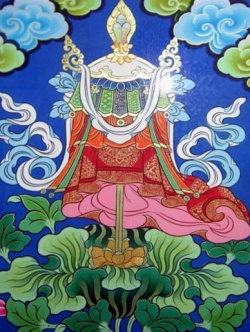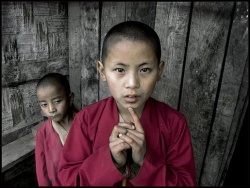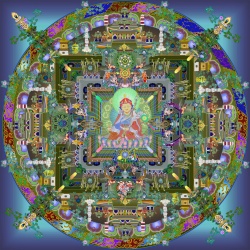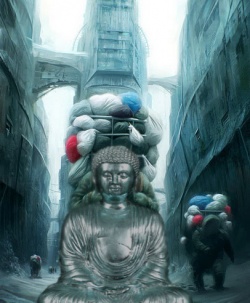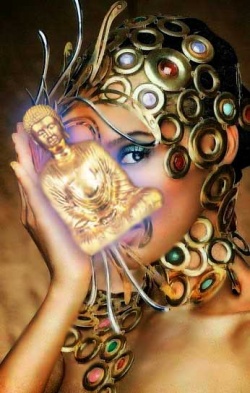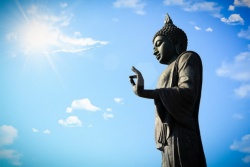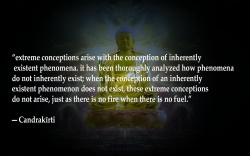Difference between revisions of "Early Buddhism's Model of Awakening"
| Line 7: | Line 7: | ||
The two types of persons destined towards [[stream entry]] is; | The two types of persons destined towards [[stream entry]] is; | ||
| − | 1) a [[faith]] | + | 1) a [[faith follower]], and |
2) a [[dhamma-follower]]. ([[Khanda Sutta]]) | 2) a [[dhamma-follower]]. ([[Khanda Sutta]]) | ||
Revision as of 09:00, 13 August 2014
Someone asked me to write something about the ten fetters, so this is what I wrote:
In the Pali suttas, the Buddha teaches two types of persons destined towards stream entry, and four types or stages of aryans (awakened beings).
The two types of persons destined towards stream entry is;
1) a faith follower, and
2) a dhamma-follower. (Khanda Sutta)
What is a faith follower? A faith follower is someone who accepts by faith and conviction, that all conditioned dharmas/phenomena - that is, the five aggregates, are inconstant, changeable, alterable, arising and passing, and also are unsatisfactory and ungraspable, and that all dharmas (conditioned and unconditioned) are empty of a self. If you have such a view, even by faith, the Buddha assures that you will never be capable of performing non-virtuous deeds that are so serious as to land you in the three lower realms (hell, animal, hungry ghost), and furthermore you are assured to attain stream-entry before you die in this life.
So even if you are not yet awakened but you want some kind of assurance for your liberation, and you have some faith in the Buddha's teachings, get right view (which is the forerunner of the noble eightfold path). That alone is enough for an assurance for your Nirvana. And it isn't really difficult - after all, you don't even need to be an expert in the Madhyamika or the Abhidharma, you just need to understand it and accept it by faith, even that alone serves as an assurance. When you have the right view, your entire life will naturally be directed or led towards realizing this truth, there is no turning back.
And what is a Dharma follower? A Dharma follower is someone who goes a step further than the faith follower, a dharma follower is someone who after "pondering with a modicum of discernment" (that is, after intellectually analyzing and concluding that all phenomena are such, for example, by following the Madhyamika or Abhidharma analysis, or just reading the suttas or sutras) and perhaps with a little experience with vipassana meditation (not to the point of direct realization) has accepted that all the conditioned dharmas are impermanent, (as mentioned above), unsatisfactory, and all dharmas are empty of self. Again, such a person is said to be (as similar to the above) someone who has 'entered the orderliness of rightness, entered the plane of people of integrity, transcended the plane of the run-of-the-mill'. He is incapable of doing misdeeds (as mentioned above) that can land him in the three lower realms, he is incapable of dying before he realizes the fruit of stream entry.
Now, those two types of people I have just mentioned above, those are people who only had an intellectual view, one is accepted by faith in the Buddha's dharma, and one is concluded through intellectual analysis. Even these people have the assurance that they will attain awakening (at least the first stage of awakening) before they die. But those are still not awakened people. Awakening starts at stream entry (sotapanna), where you become an aryan, which is then followed by three more stages of awakening: once returner (sakadagami), non returner (anagami) and arahant - which connotes the conqueror, the saint, etc.
A stream entrant, having *directly*, *experientially*, realized that all conditioned phenomena are impermanent and unsatisfactory, and are empty of a self. Having directly discerned the nature of phenomena and gaining the dharma eye that sees the arising and cessation of aggregates, realizing anatta, the stream entrant has permanently eliminated the view of a self. What this means is really such a person can no longer conceive, believe in, or hold the notion of, a real, changeless, independent self, agent, observer, doer, controller, of one's life or experiences or the aggregates. One stops conceiving of any soul, self, or even an ultimate Self (such as identifying a true self that is 'Brahman' or 'Pure Consciousness'). A stream entrant can no longer hold the view that there is such a self/Self. A stream entrant sees, realizes, there is only ever the stream of aggregates with no self behind (or within) the aggregates. And he realizes this directly, through insight meditation.
From Dhammapada verse 178:
Sole dominion over the earth,
going to heaven,
lordship over all worlds:
the fruit of stream-entry
excels them.
A stream entrant (sotapanna) is assured to never again be reborn in the three lower realms, to be only reborn in either the human realms or the deva realm (heaven), and furthermore is assured to attain complete Nirvana (cessation) of afflictions as an Arahant in no more than 7 more lifetimes. Now a stream entrant may attain arahantship in that very life if he puts some effort in his practice, but even if he didn't, he can no more exceed 7 more lifetimes in samsara. A stream entrant has eliminated the first three fetters:
1. identity view (as explained above)
2. doubt (there can be no more doubt about the Buddhadharma because you have directly realized it in your own experience)
3. ritual attachment (the belief that reliance on rituals and rules can somehow save you from samsara or end your suffering, as by now you would have realized that only by following the noble eightfold path which is summarized as the path of insight and tranquility, can suffering truly be ended, there can be no end of suffering besides through wisdom)
So once you have directly realized the dharma, and gained the Dharma Eye, you are a stream entrant that has permanently ended the above three fetters and is on an irreversible conveyer belt to Nirvana - the end of samsaric births and deaths, the end of all afflictions (passion, aggression and delusion), the end of all I and mine-making. What is the 'stream' that the stream enterer enters? The Buddha explained that the stream is the noble eightfold path, so basically such a person, having attained realization of the right view - which is the forerunner of the noble eightfold path, has entered the path which invariably leads to Nirvana.
A once returner (sakadagami) is one step further, having attenuated (lessened, weakened significantly) two more fetters: the fetter of sensual desire and the fetter of ill will. Well the fetter of sensual desire is very easy to understand: craving for good sensual enjoyment, sex, music, or even good food and chocolates, etc. Anything that has to do with desiring nice experience of the senses, that comes under sensual desire.
The fetter of ill will, well, it just means hostility, hatred, violence, thoughts of harming others, etc. All these are ill will. A once returner has significantly attenuated, though not necessarily removed completely, these two fetters. And a once returner is assured to only be reborn in either the human or the deva realm for one more life at most before attaining complete nirvana.
The non returner is a further step, having completely eliminated the fetter of sensual desire and fetter of ill will, instead of merely 'attenuating' them. Such a being, an anagami, cannot have thoughts of anger, cannot have sexual lust, and do not engage in sex. Yeah - that is what the Buddha taught, it is not what I invented (refer to Mahavacchagota Sutta - it clearly states that stream entrants and sakadagami partakes in sensual pleasures but not anagami and arahants). So if someone continues to crave sex, and engage in sexual activities, and claims to be anagami, I have good reason to doubt that, because it simply does not tally with the Buddha's definition of what anagami is. It may be that others have different ideas of what anagami means from the Buddha, but after all the four stages are defined by Buddha so we should follow his definitions when discussing it in the context of dharma as taught by him. Otherwise we simply won't understand what he is saying, what he had in mind.
Then again some may say, oh, actually I am an anagami, I so transcend these earthly desires but for some reason I am still having an active sex life. Again, I seriously would doubt such claims, because as the Buddha states, "“Bhikkhus, that one can engage in sensual pleasures without sensual desires, without perceptions of sensual desire, without thoughts of sensual desire—that is impossible." (Alagaddūpama Sutta) So in my mind, in accordance with the scriptures, all anagamis and arahants are celibates, and furthermore have no interest in pursuing the pleasures of the senses (not only sex). This is what the Buddha suggested in the suttas, and is also the position of the commentaries.
Because an anagami has completely put an end to the fetter of sensual desire and ill will, there is no more cause for becoming (rebirth) in the sensual planes - which is all the planes of samsara up to the 6 sensual devalokas (deva means celestial being, loka means world, i.e. heavens). Why? Because if you understand the four noble truths you know, becoming (that is, rebirth) and the mass of suffering is driven by craving. Craving is the cause of suffering and rebirth.
If you have craving for sensuality, and the karmas pertaining to sensuality ripens - you get reborn in the sensual planes of existence. If you have craving and attachments to the form dhyanas/jhanas (these are states of meditative absorptions), then (provided that you have the wholesome karma and meditative practice to support that desire) you get reborn in the form devalokas as a Brahma. In the form realm you still have a material body but no sensual desires, whereas in formless realms you do not have a material body. If you have craving or attachments to the formless dhyanas such as infinite space, infinite consciousness, etc, then you get reborn in those samsaric planes. Then, you experience living in those realms for kalpas, for millions of years, until eventually your karmas get exhausted (especially if you are reborn in the formless realms it is easy to get into lower realms since there is no opportunity to make merits), and then you become reborn again in the lower realms and work your way up again. So, rebirth in these devalokas without wisdom is totally insecure, they are not to be sought by Buddhists seeking for freedom. (It's another thing if you are reborn there as a stream entrant, etc, cos eventually you get back to dharma and the path and you don't stray into samsara for long)
So going back to topic, an anagami does not get reborn anymore in the sensual planes, then where does he/she get reborn to? They are reborn in the five Pure Abodes (suddhavasa) of the 4th jhana planes, of which the akanistha is the highest of them. This is the only realm where Buddha has not been reborn in before (as he stated: having recalled many aeons of past lives, he has been reborn in all samsaric realms, except the five pure abodes), because once you get reborn in it, you can never come back - that realm is literally made up of ONLY anagamis and arahants: once an anagami is born there, one will never return from that realm into another samsaric rebirth, so basically you just become an arahant there and enter into nirvana. (Mahāsīhanāda Sutta: "it is not easy to find a realm in the round that I have not already [82] passed through in this long journey, except for the gods of the Pure Abodes; and had I passed through the round as a god in the Pure Abodes, I would never have returned to this world.")
Anagamis are assured of only rebirth in such a high devaloka simply because an anagami has cut off craving from sensuality, yet, there is still the fetter of craving for form and formless jhanas (will be explained later), and this supports becoming/rebirth in a jhanic plane.
Then we have an arahant. An arahant fully removes 5 more fetters and no longer takes birth in samsara after his/her parinirvana:
lust for material existence, lust for material rebirth (rūparāgo)[12]
lust for immaterial existence, lust for rebirth in a formless realm (arūparāgo)[13]
conceit (māna)[14][15]
restlessness (uddhacca)[16]
ignorance (avijjā)[17]
Material existence and immaterial existence here refers to the jhanic planes. So how can you have craving for jhanic planes? As I mentioned before, the meditative absorptions of jhanas are incredibly blissful and sublime. They are much more blissful than any sensual pleasures you have ever experienced. As Ajahn Brahmavamso said, jhanas are more blissful than sex. And it is on an entirely different level too.. the mental peace, intense joy and bliss, and equanimity, and mindfulness, these are very good, very wholesome mental factors. So it is nothing like the coarse sensual pleasures we get from drugs, intoxication, sex, etc etc which only leads to heedlessness and delusion. This is why jhanas is part of the noble eightfold path, the practice of right concentration. Jhanas are to be developed. They support the development of wisdom, they support the complete liberation from defilements, so it is important.
However these states are like any other conditioned phenomena marked by transciency, unsatisfactoriness, and are not-self, not-mine. By not perceiving the nature of all states, they can become object of attachment and craving. That is why some people who have no wisdom at all (that is, they are not even stream entrants) may get stuck on practicing jhanas the wrong way - that is, instead of using it as a support to develop wisdom they completely get attached to those states and become what is called "jhana junkies". If you have proper guidance I don't think you will fall into such a category of people. These jhana junkies only know how to sit all day, get into meditative bliss, and then when they die the cycle of rebirth continues, they get reborn in the higher devalokas for a long time but that is about it, eventually they return back to lower realms (like all sentient beings do eventually, if they did not encounter dharma).
So anyway as I was saying, these material existence and immaterial existence are so sublime and blissful and peaceful, so it is only at the very last stage of the path to personal liberation - that is, arahantship, that all attachments to the jhanic factors are completely removed, and with it, the causes for rebirth in these jhanic planes too are removed. Although stream entrant onwards have perceived directly the impermanence/dukkha/anatta of all phenomena, nonetheless subtle remnants or residue of ignorance persists that could lead to craving.
Regarding conceit, well, I've already spoken a little about it recently so I'll just cut and paste it here:
Many people translate the fetter of conceit as 'pride', however, the fetter of conceit is not just in the sense of being 'proud'. I mean, pride etc is definitely a fetter. But also some people can be very humble, yet it does not mean they have overcome their 'I Am conceit'.
The 'I Am conceit' is more specifically described as a kind of trace, like a stench left over in a jug when the contents of the jug has been poured away. That trace of self remains after realization of anatta and then one has to liberate even that trace itself. That liberation of trace is Arahantship. This is clearly described in the Khemaka Sutta.
The Buddha said:
Blissful is passionlessness in the world, The overcoming of sensual desires (i.e. anagami); But the abolition of the conceit "I am" (i.e. arahantship) — That is truly the supreme bliss.
So what is the difference between the 'view of self' and the 'trace of self'?
As Thusness wrote to me in 2011:
Session Start: 29 March 2011
Thusness: yeah of course
AEN: Ic
Thusness: if u do not feel the 'body construct' and 'mind construct', just the play of dharma, how does the sense of self arise?
AEN: It doesnt
Thusness: yeah...
Thusness: for me, it is just this dependent originated activity...
Thusness: primordially pure and luminous
Thusness: sense of self does not arise
Thusness: i do not see 'body' or 'mind'
Thusness: for there is no agent
Thusness: for u by now u should be clear on this
Thusness: experientially
Thusness: otherwise, u will not feel the 'process'
AEN: Ic..
Thusness: u told me about the mini maha experience
Thusness: so u should not feel the sense of self
AEN: Yea
Thusness: logically when the agent is gone, the primary cause for these sense of self should also be gone
Thusness: however due to the deeper dispositions, it continues to linger
Thusness: when u engage in this modern world, it re-enfore the identity
Thusness: so by seeing there is no-self in anatta, the sense of self should also dwindle
AEN: Ic
Thusness: when u practice and there is mind body drop
Thusness: due to de-construction of body and mind
Thusness: there is only purity of sensations
Thusness: it is just a lingering trace
Thusness: how does the sense of self arise?
Thusness: and that means it is simply a dispositions
Thusness: and during daily activity, there is re-enforcing of this trace
Thusness: when there is no agent, this trace will be seen as it is
Thusness: in non-dual and one mind, this is not just a trace
Thusness: u may have trace of identity
Thusness: but 'Self' (comments: self-view) is not a trace
Thusness: it is as if it is truly 'there' and all there is
Thusness: but anatta is different
Thusness: for everything is like a trace
Thusness: and self is not any more special that an arising sound
Thusness: no diff
Thusness: can u understand the difference?
Now the 9th fetter which an arahant has eliminated:
restlessness (uddhacca)[16]
Restlessness is defined in "the excitement of mind which is disturbance, agitation of the heart, turmoil of mind." (Dhammasangani 429).
And this is a fetter that is only removed completely by an arahant. So it's very normal that you have a restless mind, a monkey mind, a distracted mind. We all experience that (well unless you're an arahant!). First we have a thought of X, and then from that thought X it drifts off into Y and Z and an endless chain of thinking, worries, pondering, etc. An analogy I gave is like it's reading the news feed on facebook. You scroll from one to another mindlessly, grasping to another post before leaving the previous post. We get distracted from time to time. In fact if you think you never get distracted, try sitting down in meditation, just watch your mind. Soon you'll realize how distracted you are but only you didn't notice it before. But at the same time if you sit a little longer, everything starts to tranquilize, mind and body tranquilizes and bliss happens.
Anyway. So, an arahant is someone who does not have restlessness. What this means, in my understanding, is that arahant does not have discursive thinking at all. They don't have a wandering mind. They don't daydream. They don't get distracted. They never get agitated. The only thoughts they have are wholesome, beneficial, necessary thoughts. They don't get excited and from thought X jump into Y, Z, etc, an endless chain of agitated thinking. And they aren't just in a state of equanimity in meditation - that is easy, but they are in equanimity in every moment in their life, through its ups and downs. They are not happy when they gained something nice, they are not unhappy when they lost something, in fact, sense of ownership never comes up in their mind at all.
The Buddha says that arahants are completely fearless. Arahants are free from hope and fear, they are free from craving for life and fear of death, they are free from any kinds of craving or fear at all. In the Dhammapada, a newly attained arahant climbs down from a very high pole to meet the Buddha without the slightest fear, he does not fear falling to his death. They have no worries at all. And they have no sorrow even at the death of their closed ones. Their minds are not affected at all in life, they do not experience agitation, their minds are like a calm, serene lake. So that's arahant's mind - complete peace, non-disturbed, equanimity... arahants are the "cooled ones" according to Buddha.
Honestly, restlessness (discursive thoughts) is the strongest fetter I have. I don't have much sensual craving or ill will or anger or any of those fetters mentioned, but my mind wanders, gets distracted, I believe like all or most of us here. Sometimes it settles down in meditation but in daily life there are so many things to think about... until mindfulness returns, and then there is complete intimacy with the appearance at hand and at the same time everything self-releases, thoughts gets released.
Lastly it is the fetter of ignorance (avijjā) that the arahant overcomes -- the Buddha defines ignorance as ignorance of the four noble truths, but the four noble truths is linked all the truths that we discover - impermanence, unsatisfactoriness/suffering, not-self, dependent origination, etc. So if you truly, fully, comprehend the four noble truths, you also overcome the perception of permanence, satisfactoriness, self, independence, inherency, and so forth.
If you see the four noble truths, you clearly see dependent origination in action. You clearly perceive that suffering - the eight kinds of suffering - is rooted in craving, in grasping, in delusion, and you clearly perceive that there is path which leads to the end of that craving, that grasping, that delusion.
So you see dependent origination Directly, not just as an inference, but you see ignorance in action - what does ignorance means? What does karmic propensities mean? Many of us think of karmic propensities and ignorance as being some kind of ghostly, hidden, almost mystical force hiding somewhere and affecting our lives from a hidden 'subconscious' component of consciousness stored away from sight. That is having an inherent view, a self-view of ignorance and karmic propensities. We need to directly See that cause of suffering and that suffering as the total exertion of our experience in seamless dependencies.
As Thusness say, having the view of afflicted dependent origination is having the enlightened view. The enlightened view does not conceive of a sufferer, suffering does not come from a self. How does it arise? Based on conditions - delusion, grasping, craving.
The totality of our experience is being shaped moment by moment by our delusions (either that, or by wisdom), by our sense of self, and with it all kinds of grasping and craving and afflictions. Taste it, see it for yourself, what is it like? See that grasping in action, see that becoming in action, see the birth of suffering. Only when you see suffering and the cause of suffering, only then can you realize the path and the end of that suffering. (Otherwise you become some neo-advaitins that say the path is not necessary)
And the moment you perceive the nature of that - that every phenomena is dependently arising, is empty of a self, is empty of inherent existence, at that moment, by realizing the four noble truths you realize dependent origination and you realize emptiness. And with that, you attain liberation. That is how overcoming the ignorance of the four noble truths is so crucial. From a view that a Subject interacts with an Object, to a view of seamless process of dependencies without self/Self, and furthermore clarity into the workings of delusion, grasping, craving I-making and suffering.
Conclusion:
The early Buddhism's model of awakening as taught by Buddha are a series of (four) stages in progressively terminating the three poisons of passion/craving/lust/desire, aggression/anger/ill-ill, and delusion/ignorance, which are the causes of all suffering and samsaric births. This results in release from mental afflictions and any further re-births/becoming in the cycle of samsara. That is the end of suffering, also known as Nirvana. How is Nirvana attained? By perfecting the three trainings of ethical conduct/morality (Sīla), meditative composure (Samādhi) and discernment/wisdom (Paññā).
